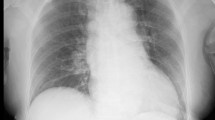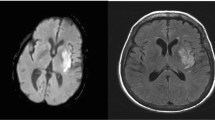Abstract
Aortic dissection masquerading as ischemic stroke is particularly challenging in the era of thrombolysis as a result of narrow diagnostic time window and severe hemorrhagic potential. We describe a case of a 77-year-old patient with a presumed ischemic cerebral infarct, in whom planned treatment with tissue plasminogen activator therapy (TPA) was withheld because of partial spontaneous improvement in his condition. Shortly afterwards, newly elicited clues in the medical history and physical examination led to timely diagnosis and treatment of ascending thoracic aorta dissection, which was the underlying disorder. Analysis of the features of this case and similar previously published cases illustrates the importance of using and mastering basic diagnostic skills.

Similar content being viewed by others
References
De Sanctis RW, Doroghazi RM, Austen WG, Buckley MJ. Aortic dissection. N Engl J Med. 1987;317:1060–67.
Gerber O, Heyer EJ, Vieux U. Painless dissections of the aorta presenting as acute neurologic syndromes. Stroke. 1986;17:644–47.
DeBakey ME, McCollum CH, Crawford ES, et al. Dissection and dissecting aneurysms of the aorta: twenty years follow-up of 527 patients treated surgically. Surgery. 1982;92:1118–34.
Khan IA, Nair CK. Clinical, diagnostic, and management perspectives of aortic dissection. Chest. 2002;122:311–28.
The National Institute of Neurological Disorders and Stroke rt-PA Stroke Study Group. Tissue plasminogen activator for acute ischemic stroke. N Engl J Med. 1995;333:1581–87.
Kamp TJ, Golschmidt-Clermont PJ, Brinker JA, Resar JR. Myocardial infarction, aortic dissection, and thrombolytic therapy. Am Heart J. 1994;128:1234–37.
Flemming KD, Brown RD Jr. Acute cerebral infarction caused by aortic dissection: caution in the thrombolytic era. Stroke. 1999;30:477–8.
Fessler AJ, Alberts MJ. Stroke treatment with tissue plasminogen activator in the setting of aortic dissection. Neurology. 2000;54:1010.
Villa A, Molgora M, Licari S, Omboni E. Acute ischemic stroke, aortic dissection, and thrombolytic therapy. Am J Emerg Med. 2003;21:159–60.
Wright V, Horvath R, Baird AE. Aortic dissection presenting as acute ischemic stroke. Neurology. 2003;61:581–2.
Uchino K, Estrera A, Calleja S, Alexandrov AV, Garami Z. Aortic dissection presenting as an acute ischemic stroke for thrombolysis. J Neuroimaging. 2005;15:281–3.
Chua CH, Lien LM, Lin CH, Hung CR. Emergency surgical intervention in a patient with delayed diagnosis of aortic dissection presenting with acute ischemic stroke and undergoing thrombolytic therapy. J Thorac Cardiovasc Surg. 2005;130:1222–4.
Elkind MS, Sacco RL. Stroke risk factors and stroke prevention. Semin Neurol. 1998;18:429–40.
Nienaber CA, Eagle KA. Aortic dissection: new frontiers in diagnosis and management: Part I: from etiology to diagnostic strategies. Circulation. 2003;108:628–35.
Earnest F 4th, Muhm JR, Sheedy PF 2nd. Roentgenographic findings in thoracic aortic dissection. Mayo Clin Proc. 1979;54:43–50.
Nienaber CA, Eagle KA. Aortic dissection: new frontiers in diagnosis and management: Part II: therapeutic management and follow-up. Circulation. 2003;108:772–8.
Tsai TT, Evangelista A, Nienaber CA, et al. Long-term survival in patients presenting with type A acute aortic dissection: insights from the International Registry of Acute Aortic Dissection (IRAD). Circulation. 2006;114(1 Suppl):I350–6.
Acknowledgements
We thank Israel Potasman, MD, whose mentoring was invaluable for the preparation of the manuscript and Richard Lincoln for proofreading of the manuscript.
Conflict of Interest
None disclosed.
Author information
Authors and Affiliations
Corresponding author
Rights and permissions
About this article
Cite this article
Grupper, M., Eran, A. & Shifrin, A. Ischemic Stroke, Aortic Dissection, and Thrombolytic Therapy—the Importance of Basic Clinical Skills. J GEN INTERN MED 22, 1370–1372 (2007). https://doi.org/10.1007/s11606-007-0269-2
Received:
Revised:
Accepted:
Published:
Issue Date:
DOI: https://doi.org/10.1007/s11606-007-0269-2




